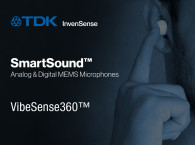
In addition, the LSM6DSV16BX contains STMicroelectronics' Qvar charge-variation detection technology for user-interface controls such as touching and swiping. It is ideal for applications such as true wireless stereo (TWS) earbuds, ANC headphones, and augmented-, virtual-, and mixed-reality (AR/VR/MR) headsets.
While delivering unprecedented integration, the LSM6DSV16BX brings superior features to the ear. The sensor embeds ST’s Sensor Fusion Low Power (SFLP) technology, specifically designed for head tracking and 3D sound, and the in-the-edge processing resources featured in ST’s third-generation MEMS sensors. These include the Finite State Machine (FSM) for gesture recognition, the Machine-Learning Core (MLC) for activity recognition and voice detection, and adaptive self-configuration (ASC), which automatically optimizes performance and efficiency. These help to reduce system latency while saving overall power and offloading the host processor.

Together, the enhanced integration and in-the-edge processing save up to 70% of system power consumption and 45% of PCB area. In addition, the number of pin connections can be reduced by 50%, thereby saving external connections, and the package height is 14% less than preceding ST MEMS inertial sensors.
The LSM6DSV16BX comes with many software examples, available on ST MEMS GitHub FSM and MLC model zoo. These include pick-up gesture detection to automatically turn on some device’s services, in-ear and out-of-ear detection in TWS headsets, head gestures for 3D sound in headphones, and many more. To save developer time, without starting from scratch, pre-integrated application examples are available in X-CUBE-MEMS1 package.
The LSM6DSV16BX is in production now, available in a 2.5mm x 3.0mm x 0.74mm VFLGA package, priced from $3.95, for orders of 1000 pieces.
www.st.com/lsm6dsv16bx







